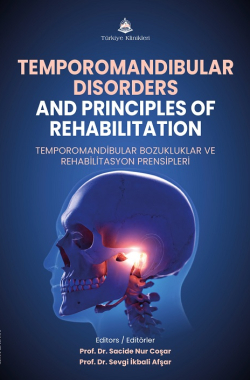SPINE PATHOLOGIES ACCOMPANYING TEMPOROMANDIBULAR DISORDERS
Ebru Sever1
Halil Atmaca2
1Kocaeli Health and Technology University, Faculty of Health Sciences, Department of Physiotherapy and Rehabilitation, Kocaeli, Türkiye
2Kocaeli Health and Technology University, Faculty of Health Sciences, Department of Physiotherapy and Rehabilitation, Kocaeli, Türkiye
Sever E, Atmaca H. Spine Pathologies Accompanying Temporomandibular Disorders. In: Coşar SN, Afşar Sİ editors. Temporomandibular Disorders and Principles of Rehabilitation. 1st ed. Ankara: Türkiye Klinikleri; 2025. p.29-34.
ABSTRACT
The temporomandibular joint (TMJ) is a synovial joint located between the mandible and the temporal bone, allowing both hinge and sliding movements. The articular disc is positioned between the mandibular condyle and the mandibular fossa of the temporal bone, distributing loads during movement. The joint capsule and ligaments provide stability, while the masseter, temporalis, and pterygoid muscles control jaw movements. TMJ is closely related to mastication, speech functions, cervical spine, and posture, meaning that issues in the neck region can affect joint function. TMJ disorders are multifactorial pathologies that affect the functional integrity of the head-neck complex and are often associated with spinal dysfunctions. When evaluated from an osteopathic perspective, it is known that the TMJ has direct fascial connections with the cervical spine and effects extending to the thoracic and lumbar regions through postural chains. The balance of the craniomandibular system can affect cervical lordosis through fascial connections and can pave the way for the development of kyphotic posture as a result of adaptive mechanisms. From a biomechanical perspective, it has been shown that the TMJ can cause cervicogenic pain in association with malocclusion, jaw closure disorders and muscle imbalances. Hypomobility occurring in the lower cervical segments or upper cervical instability can increase the severity of temporomandibular dysfunction by disrupting the coordination of mandibular movements. Imbalances in load transfer along the spine, especially scoliosis and postural asymmetries, are known to lead to functional adaptations reflected in the jaw joint. From a kinesiological perspective, the neuromuscular interaction between the TMJ and cervical muscle groups plays a critical role in determining head and neck posture. Overactivity of the sternocleidomastoid, upper trapezius, and suboccipital muscle groups may aggravate the clinical symptoms of temporomandibular dysfunction. In addition, overactivity of the masticatory muscles and the resulting myofascial tension may affect proprioceptive responses in spinal segments, causing global postural imbalances. In this context, TMJ dysfunctions should be evaluated not only as a local problem but as part of the entire postural system. A holistic rehabilitation approach requires a multidisciplinary assessment and treatment plan that integrates osteopathic, biomechanical, and kinesiological factors.
Keywords: Etiology; Posture; Spine; Temporomandibular disorders, Temporomandibular joint
Kaynak Göster
Referanslar
- Molinari F, Effat K, Manfredini D, Colletti G, Beltrame A, Lazzarini D, et al. Temporomandibular joint soft-tissue pathology, I: Disc abnormalities. Semin Ultrasound CT MRI. 2007;28(3):192-204. [Crossref] [PubMed]
- Jacobson A. Orofacial pain: guidelines for assessment, diagnosis, and management. Am J Orthod Dentofacial Orthop. 2008;134(1):171. [Crossref] [PubMed]
- Rathod D. Internal derangement of temporomandibular joint etiology, pathophysiology, diagnosis and management: A re view of literature. Int J Adv Res. 2016;2(7):643-9. [Crossref]
- Perinetti G. Temporomandibular disorders do not correlate with detectable alterations in body posture. J Contemp Dent Pract. 2007;8(5):60-7. [Crossref]
- Lippold C, Danesh G, Schilgen M, Drerup B, Hackenberg L, Moiseenko T, et al. Relationship between thoracic, lordotic, and pelvic inclination and craniofacial morphology in adults. Angle Orthod. 2006;76(5):779-85. [Crossref] [PubMed]
- Bracco P, Deregibus A, Piscetta R. Effects of different jaw relations on postural stability in human subjects. Neurosci Lett. 2004;356(3):228-30. [Crossref] [PubMed]
- Fujimoto M, Hayakawa L, Hirano S, Watanabe I. Changes in gait stability induced by alteration of mandibular position. J Med Dent Sci. 2001;48(4):131-136.
- CucciaA, Caradonna C. The relationship between the stomatognathic system and body posture. Clinics. 2009;64(1):61-6. [Crossref] [PubMed] [PMC]
- Detoni R, Hartz CS, Fusatto EL, Bicalho E, Nacimento-Moraes KSG, Rizzatti-Barbosa CM, et al. Relationship between osteopathic manipulative treatment of the temporomandibular joint, molar shim and the orthostatic position: a randomized, controlled and double blinded study. J Bodyw Mov Ther. 2022;29:187-97. [Crossref] [PubMed]
- Raya CR, Plaza-Manzano G, Pecos-Martín D, Ferragut-Garcías A, Martín-Casas P, Gallego-Izquierdo T, et al. Role of upper cervical spine in temporomandibular disorders. J Back Musculoskelet Rehabil. 2017;30(6):1245-50. [Crossref] [PubMed]
- Becker RM. Joint Vibration Analysis (JVA) and the diagnostic process in temporomandibular disorders (TMD). In: Handbook of Research on T-Scan Technology Applications in Dental Medicine. IGI Global Scientific Publishing; 2025: 875-976. [Crossref]
- Greenbaum T, Dvir Z, Emodi-Perlman A, Reiter S, Rubin P, Winocur E. The association between specific temporomandibular disorders and cervicogenic headache. Musculoskelet Sci Pract. 2021;52:102321. [Crossref]
- Matheus RA, Ramos-Perez FM, Menezes AV, Ambrosano GMB, Haiter-Neto F, Bóscolo FN, et al. The relationship between temporomandibular dysfunction and head and cervical posture. J Appl Oral Sci. 2009;17(3):204-8. [Crossref] [PubMed] [PMC]
- Öztürk K, Danışman H, Akkoca F. The effect of temporomandibular joint dysfunction on the craniocervical mandibular system: A retrospective study. J Oral Rehabil. 2024;51:469-75. [Crossref] [PubMed]
- Minervini G, Franco R, Marrapodi MM, Crimi S, Badnjević A, Cervino G, et al. Correlation between temporomandibular disorders (TMD) and posture evaluated through the diagnostic criteria for temporomandibular disorders (DC/ TMD): A systematic review with meta-analysis. J Clin Med. 2023;12:2652. [Crossref] [PubMed] [PMC]
- Kim D, Ko SG, Lee EK, Jung B. The relationship between spinal pain and temporomandibular joint disorders in Korea: A nationwide propensity score-matched study. BMC Musculoskelet Disord. 2019;20:631. [Crossref] [PubMed] [PMC]
- Uçar İ, Batın S, Arık M, Payas A, Kurtoğlu E, Karartı C, et al. Is scoliosis related to mastication muscle asymmetry and temporomandibular disorders? A cross-sectional study. Musculoskelet Sci Pract. 2022;58:102533. [Crossref] [PubMed]
- Nakashima A, Nakano H, Yamada T, et al. The relationship between lateral displacement of the mandible and scoliosis. Oral Maxillofac Surg. 2017;21(1):59-63. [Crossref] [PubMed]
- Ikemitsu H, Zeze R, Yuasa K, Izumi K. The relationship between jaw deformity and scoliosis. Oral Radiol. 2006;22(1):14-17. [Crossref] [PubMed]

